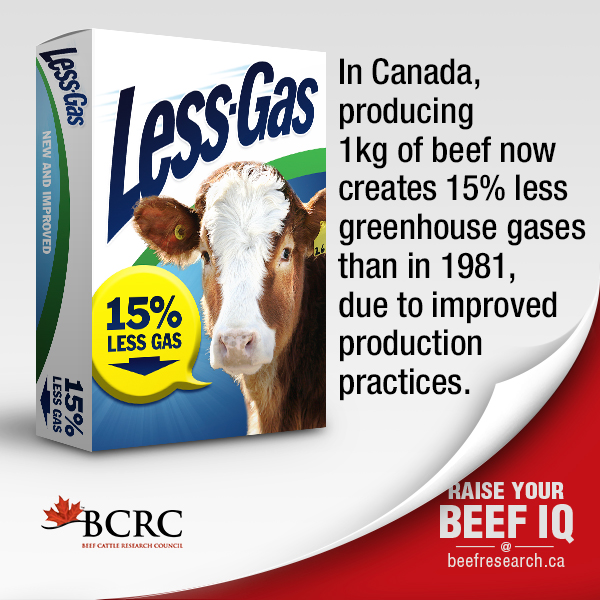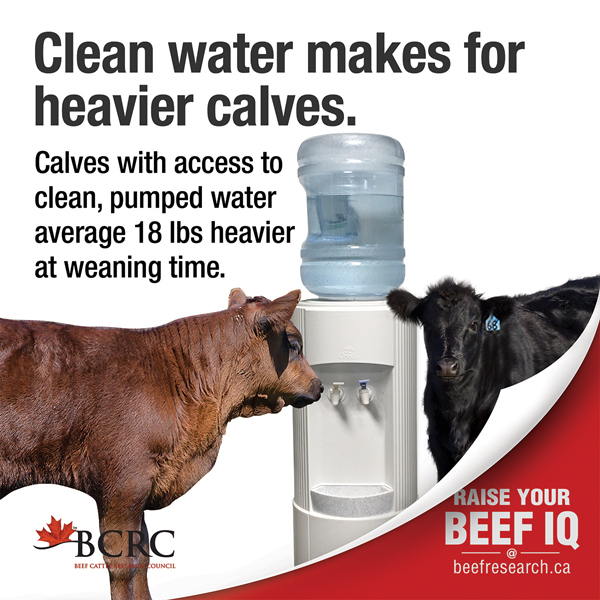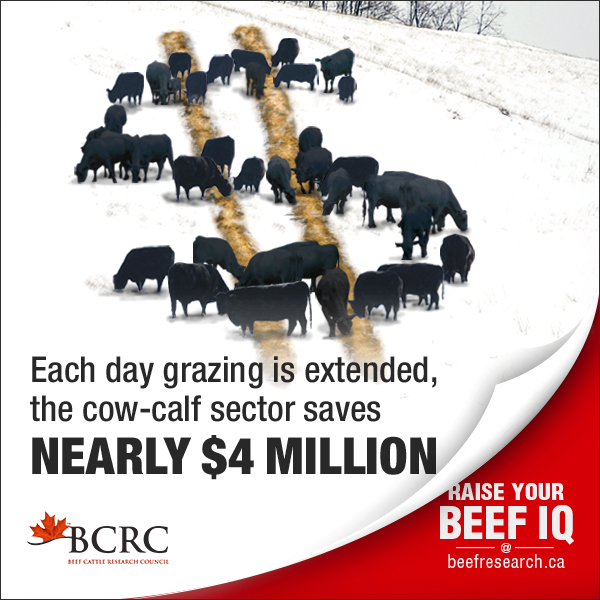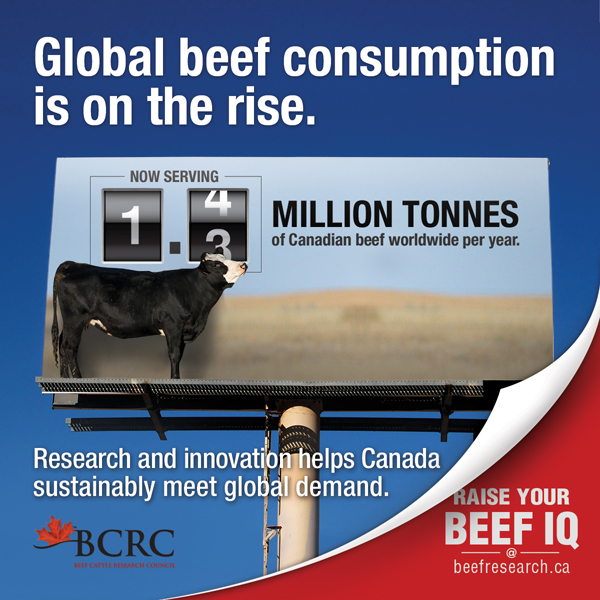The BCRC is Asking for More Money From Cattle Producers. Here’s Why.
Editor’s note: The following article is by Bryan Thiessen, Chair of the Beef Cattle Research Council. Bryan manages Namaka Farms near Strathmore, Alberta and represents 11 more council members who farm and ranch across Canada.

As cattle producers, you and I have been helping to fund Canadian beef research since 2002 by paying check-off every time we sell an animal. The work that’s been done with that money has benefited the industry as a whole and at the individual farm level because of the information and innovations that come as a result. Now we’re being asked to contribute more of our dollars.
To explain why, I need to back up and give you some background.
- Want the abbreviated version of this article? Download a printable 2 page version.
In 2014 industry leaders spent a lot of time working together to put existing national and provincial beef groups’ strategies down on paper in a single document. They did that to compare notes, to demonstrate how they were rowing in the same direction, and to look for gaps or more opportunities they could work on that would help the Canadian beef industry be more successful more quickly. That document is called the National Beef Strategy. It lays out a collaborative business plan to use combinations of research, marketing and promotion, policy development and stakeholder engagement to increase production efficiencies, reduce cost disadvantages compared to main competitors, increase carcass cutout values, enhance synergies within industry and connect positively with consumers, the public, government, and partner industries.
What is the National Beef Strategy?
Visit www.beefstrategy.com for introductory videos, summaries and the full Strategy document.
Two forces nudged the industry groups into documenting and fleshing out a formal strategy. First is that with cattle numbers being down across much of the world and demand for high quality protein increasing in most developing nations, our industry now has a huge opportunity ahead of us to supply that growing demand and we don’t want to miss it. Second, between inflation and fewer cattle numbers, the industry has fewer dollars to work with and those dollars aren’t stretching as far as they once did.
There has been a $1 per head national levy on the sale of every live animal in Canada since 2002. It funds research as well as market development and promotion of Canadian Beef. That national levy, called The Canadian Beef Cattle Check-off, needs to be $2.50 per head if we’re going to accomplish the objectives in the National Beef Strategy. There is firm support from provincial cattle associations. Each province has its own unique processes with their respective members and governments, but most provinces will be collecting the increased $2.50 Canadian Beef Cattle Check-off by the end of 2018. When it comes to deciding how much of the check-off is spent on research or marketing, each province decides that for themselves. Here at the Beef Cattle Research Council (BCRC) is where all of the funding allocated to research is administered. Canada Beef is the organization that looks after market development and promotion. Administration of the national levy is done by the Canadian Beef Check-Off Agency.
Who is the BCRC?
The BCRC is the national beef cattle industry research agency. It plays an important role in identifying the industry’s research and development priorities and subsequently influencing public sector investment in beef, cattle and forage research.
The BCRC is guided by the National Beef Research and Technology Transfer Strategy.
Learn more about the BCRC under the ‘About Us’ tab on www.beefresearch.ca
Right now the BCRC receives an average of 18 cents from the $1 national check-off, which, for reference, amounted to $1,288,478 last year. We use your money to leverage additional investments in beef research from governments. That’s an important point. Government doesn’t issue cheques without clear proof that the research programs they’re being asked to support are very important to industry. Ponying up our own cash is the necessary clear proof.
When you look at the National Beef Strategy, you see that some of the goals are to
- validate and enhance the Canadian Beef Advantage,
- increase, maintain and enhance consumer confidence,
- address social license issues of priority,
- increase productivity through investments in genetic selection, research and development, technology development and extension, and
- support long-term competitiveness through investments in new and priority research capacity, and priority research to support long-term industry sustainability.
Have questions about the Canadian Beef Cattle Check-off? Click here.
The BCRC is responsible for helping to achieve those. To do the work needed to help achieve them, the BCRC needs annual funding of $11.8 million. Therefore, the BCRC is proposed to get 75 cents of a $2.50 per head Canadian Beef Cattle Check-off, which would be about a total of $4,000,000 of industry funding each year. The BCRC can use that industry money to leverage the additional funding needed by applying to federal and provincial government partners, as well as industry stakeholders like other check-off groups, NGOs, and supply chain stakeholders.
Why is it necessary to do more work than we already are and achieve those goals? Because food demand in Canada and around the world is expected to continually grow but we don’t have any more agriculture resources (like land) to use. More research and development is needed so that we can continue improvements that allow our industry to produce more product with fewer resources, while staying competitive globally and competitive with other agricultural commodities.
Why does industry need to pay for it? Government investment in agriculture research is under significant pressure. Governments are directing less funding to agriculture research, and their decision making process is more stringent. Lately, in many areas of priority, government funding and resources are limited unless industry invests too. Pressure on government funds means less for research projects, but also means less for the infrastructure and experts needed to do research projects. Industry is increasingly required to invest in those things, as well as the extension to get the results from the bookshelf and technical papers into your hands in meaningful and useful ways.
As an industry, we have a responsibility to help pay for the beef research and extension that benefit us and to work more closely with government to ensure priority research is invested in. There’s also a broader range of research needed now because fewer and fewer people have connections to the farm and therefore the public has little understanding about agriculture. We not only want to invest in research focused on beef production, we also now need research to support public confidence and trust. Science must extend beyond meat quality and safety, feed production and efficiency, and animal health and productivity. It needs to also cover animal welfare, environmental impacts, antimicrobial resistance and more to make improvements and factually demonstrate what industry is doing so we can continue to produce our great product in the best ways.
An increased check-off will enable our industry to address high priority research that is not currently being addressed by industry, and will also ensure BCRC can maintain the existing level of programming and not have to cut back the amount of research we’re currently supporting. The BCRC had previously been able to build up a reserve to fund research programming, but with declining marketings resulting in declining check-off revenues, it has been drawing down that reserve to a point of depletion to be able to fund high priority research.
Here are some examples of the research the BCRC has funded lately:
Animal Health and Welfare
- Implement a longitudinal disease surveillance network for cow‐calf operations in western Canada (with hopes of expanding it across the country). Results to date include that 43% of cows in western Canadian herds are copper deficient.
- Study the effect of age of beef cattle on pain, as well as pain mitigation during routine management procedures. Results to date clearly indicate that calves castrated at 1 week of age exhibit very few physiological or behavioral responses indicative of reduced welfare.
Feed Grains, Feed Efficiency, and Forage and Grassland Production
 Provide Canada’s beef industry with a package of improved tame and native forages. Results from mixture studies are yielding results in drought adaptation.
Provide Canada’s beef industry with a package of improved tame and native forages. Results from mixture studies are yielding results in drought adaptation.- Define how the environmental footprint of the Canadian beef industry has changed over the years, access whether cattle production impacts ecosystem health, how pasturelands store carbon, and affect wetlands and habitat for species at risk. Results to date include: Canada produced 32% more beef in 2011 than in 1981. Producing the same amount of beef in 2011 required 29% less breeding stock, 27% fewer slaughter cattle and 24% less land, and produced 15% less greenhouse than in 1981. This science-based information is key when educating the public and in discussions with policy makers.
Beef Quality and Food Safety
- Conduct another National Beef Quality Audit (NBQA) to measure improvements in the quality of Canadian beef over time. Results found that overall consumer satisfaction remained as high in 2015 as in 2009. Results also found that quality defects, like liver damage and bruises exceed $60 per head. NBQA results tell us where we can improve. The NBQA also identifies ways in which Canadian beef may be superior to its international competitors, which supports The Canadian Beef Advantage.
- Improve education for packing plants on effective food safety procedures that are practical and cost‐effective.
Those are just a few examples. As you can see, there is valuable and exciting work happening now, but we are not tackling some of our current research priorities to the extent we should be, and some aren’t being tackled at all. We are turning down research proposals that are likely to answer the questions our industry has or could provide solutions to some of our issues because we don’t have the funds available to support those projects.
At times, our council doesn’t receive the specific proposals we want because there is no one to submit them. There is a lack of research capacity in the areas of meat science, forage development and utilization, and feeds. Concerns around research capacity are further exacerbated by the fact that many important research positions are soon to be empty, with a significant proportion of researchers being eligible to retire within the next five years. Industry investment into creating or maintaining and filling those positions would make it possible to tackle more emerging issues and have long-term work completed.
The creation of research surveillance networks would help the research world answer industry’s questions and identify problematic or beneficial trends more quickly. There would be a lot of power in the information available from monitoring resistance levels to commonly used antibiotics, or the rates of disease or nutritional needs in cattle, for example.
Instead of always investing in new research, we need to look globally as well as across sectors to see what is already available that could help to address outstanding research priorities. Rather than start from scratch, there are times that a domestic and international research liaison could work with researchers to find, understand, and adapt innovations from other regions or countries to suit Canadian producers. I can especially see this on the technology side, like virtual fencing, drones, early disease detection technologies, or surveillance technologies. Drawing from other sectors and global expertise would be more efficient with limited resources and also open up the opportunity for new technologies and innovations that have not necessarily been considered to a large extent here in Canada.
Extension is another area that the BCRC will put more investment once the national levy increases. Universities and governments have cut back their emphasis on and staff that are focused on translating and relaying scientific knowledge and tools to the industry. Without those skilled individuals dedicated to extension, we miss opportunities to improve our profitability and productivity, or prevent wrecks. Our industry can’t realize the full value of our research investments unless we’re aware of and utilize the results. The BCRC developed and implemented a Knowledge Dissemination and Technology Transfer Strategy in 2011 to convert technical research results into tools that industry can use to increase its competitiveness. It’s been successful and proven its worth, but overall the current state of beef and forage extension in Canada is still fragmented and underfunded in many cases. There are dozens of groups across the country each doing some extension work that could have a greater positive impact if they had more support, guidance and ways of sharing resources between them.
What is VBP+?
The Verified Beef Production Plus (VBP+) program enables Registered beef cattle producers to prove to consumers and retailers that they adhere to the highest standards for food safety, animal care and environmental stewardship. Learn more at http://verifiedbeefproductionplus.ca
Money from an increased check-off will also be used for the ongoing delivery of the Verified Beef Production Plus (VBP+) program, which the BCRC oversees. This would provide the verification of sound production practices that consumers are asking for. The link between science and promotion – encouraging producers via training in VBP+ to continue to focus on incremental improvements in four modules and to verify the good practices and recordkeeping they are doing to meet growing demand by customers and the public.
Those are the reasons why the BCRC is asking for more money from cattle producers.
If we want to be the most trusted and competitive high quality beef cattle producer in the world and recognized for our superior quality, safety, value, innovation and sustainable production methods, we’ve got to execute an all-hands-on-deck plan to work for it.
You’re being asked to increase the Canadian Beef Cattle Check-off from $1 per head to $2.50 per head, and to allocate a greater percentage to research. That means you and I will keep a little less of our cattle cheques, but I believe strongly it will lead to a brighter future overall. This is an investment in ourselves.
I encourage you to voice your thoughts on industry investments in research. The best place to have those discussions is at your regional cattle producer meeting this fall. You’ll find the dates, times and locations of those regional meetings through your provincial beef producers’ association or on the calendar of events on www.beefresearch.ca.
- Want the abbreviated version of this article? Download a printable 2 page version.
Keep in mind that a Canadian Beef Cattle Check-off of $2.50 per head will fund issues management, and market development and promotion too. To learn about how increased check-off will be used for those, visit:
- https://canadabeef.ca/producer/ – Look for the link to “Leveraging an increase of the Canadian Beef cattle check-off for maximum marketing return”
- http://www.cattle.ca/assets/ActionNews/action-news-171002.pdf – See the Issues Manager column in the October 2nd issue of Action News.
Sincerely,
Bryan Thiessen
Chair, Beef Cattle Research Council
Click here to subscribe to the BCRC Blog and receive email notifications when new content is posted.
The sharing or reprinting of BCRC Blog articles is welcome and encouraged. Please provide acknowledgement to the Beef Cattle Research Council, list the website address, www.BeefResearch.ca, and let us know you chose to share the article by emailing us at info@beefresearch.ca.
We welcome your questions, comments and suggestions. Contact us directly or generate public discussion by posting your thoughts below.


